Gamma Spectroscopy
High Purity Germanium Detectors
HPGe: Germanium detectors are semiconductor diodes having a p-i-n structure in which the intrinsic (i) region is sensitive to ionizing radiation, particularly x rays and gamma rays.
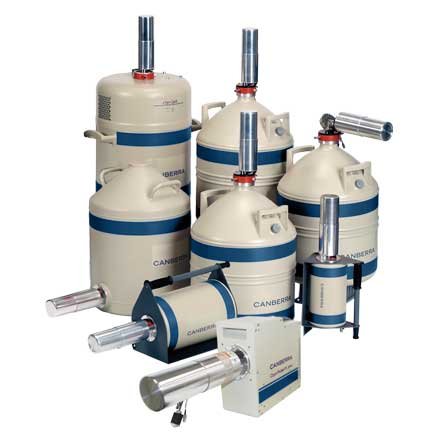
- Available in P-Type and N-Type
- Efficiency from 5% to 160%
- Higher resolution
- Intelligent pre-amplifier
Clover Detector: In the CLOVER detector assembly, the crystals are held on a minimized crystal holder to reduce the quantity of material surrounding the crystals and to improve peak to background ratio. With this principle Mirion is offering an optimized amount of HPGe material within the cap.
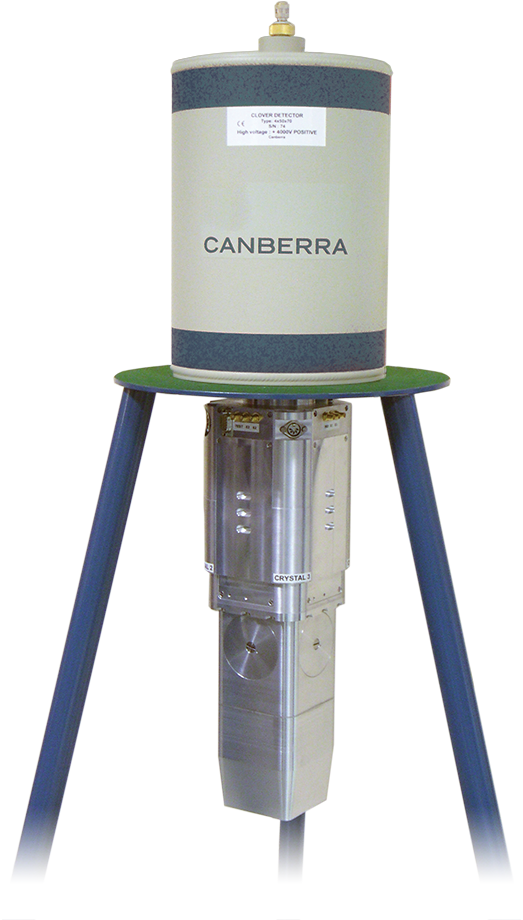
- High efficiency in 4π geometry
- High photopeak efficiency in ‘add-back’ mode
- Excellent energy resolution
- Excellent timing response
Reverse Electrode Coaxial Ge Detectors: The reverse-electrode (REGe) detector is similar in geometry to other coaxial germanium detectors with one important difference.
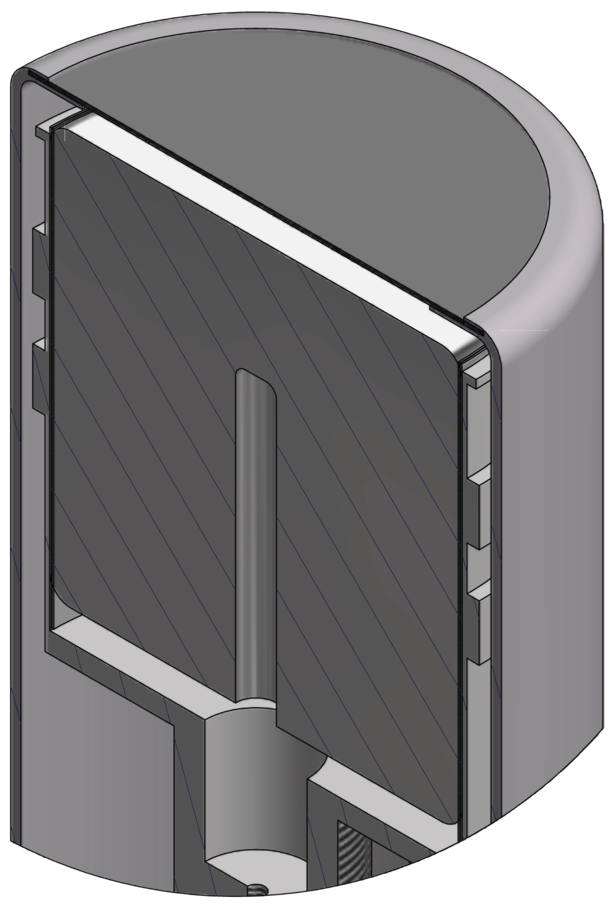
- Spectroscopy from 3 keV to >10 MeV
- Ultra-thin ion implanted contact
- Radiation damage resistant
- High energy rate capability
Standard Electrode Coaxial Ge Detectors: The conventional coaxial germanium detector is often referred to as Pure Ge, HPGe, Intrinsic Ge, or Hyperpure Ge. Regardless of the superlative used, the detector is basically a cylinder of germanium with an n-type contact on the outer surface, and a p-type contact on the surface of an axial well.

- Energy range from 40 keV to >10 MeV
- High resolution – good peak shape
- High energy rate capability
- Diode FET protection
Ultra-Low Energy Germanium Detectors: The Mirion Ultra-LEGe detector extends the performance range of Ge detectors down to a few hundred electron volts, providing resolution and peak-to-background ratios once thought to be unattainable with semiconductor detectors.
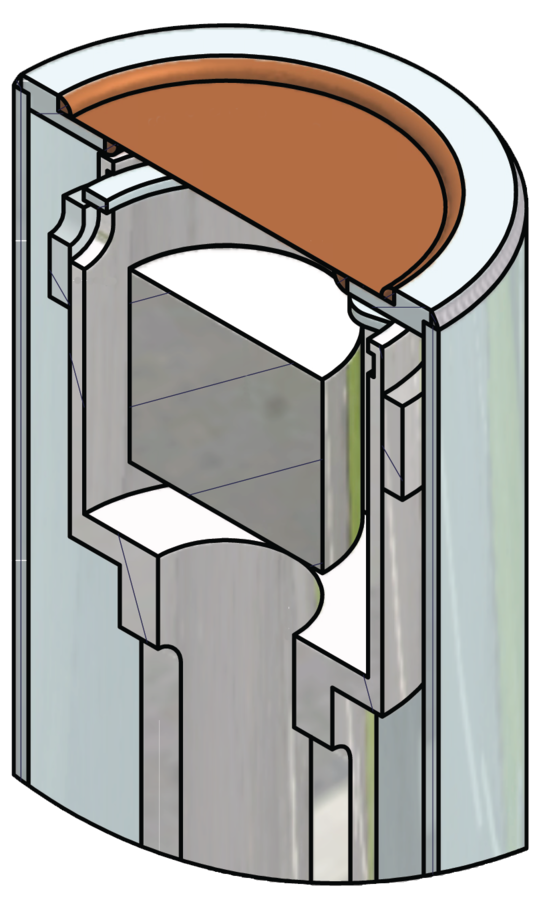
- Spectroscopy from 300 eV to 300 keV
- High efficiency compared to Si(Li) and SDD
- Excellent resolution up to very high count rates
- High peak/background ratio
Small Anode Germanium Well Detector: The Mirion SAGe™ Well Detector1 combines excellent energy resolution at low and high energies with maximum efficiency for small samples. Like Traditional Well Detectors, the SAGe Well is fabricated with a blind hole, leaving at least 20 mm of active detector thickness at the bottom of the well.

- Blind well approaches 4π counting geometry yielding high absolute efficiency
- Thin lithium diffused contact inside well allows spectroscopy from 20 keV up to 10 MeV
Special HPGE and SiLi Detectors
Lithium Detector for X-ray Spectroscopy: Silicon Lithium X-Ray Detectors are the heart of solid state x-ray spectroscopy systems. These detectors, which are p-i-n devices formed by lithium compensation or drifting of p-type silicon, are the result of some of the most carefully controlled manufacturing processes in existence.

- XRF, XRD
- Synchrotron applications (EXAFS, XANES,…)
- X-ray spectroscopy (e.g. EDS)
- PIXE
Silicon Lithium Detector for Charged Particles: Wide range of detector size: active areas from 200 mm² up to 1600 mm2; thickness 2 mm and 5 mm. Other dimension are available on request Gold entrance window 0.2 µm equivalent silicon. Lithium back contact 300 µm (50 µm for transmission option). Circular or rectangular gold plated brass mounts. Microdot female connector.
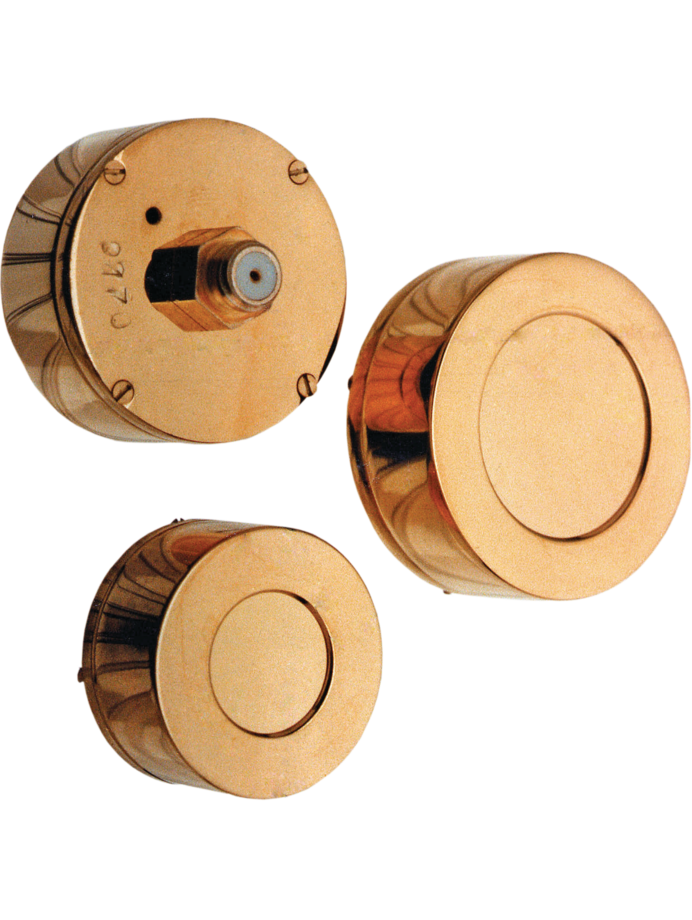
- Designed for highly penetrating charged particles
- Better stopping power than common silicon detectors: up to 3 MeV Betas, 30 MeV protons, 140 MeV Alphas. More if detectors are stacked
- Designs for room temperature or LN2 cooled applications
- Thin back contact available (transmission option) for the dE/dx measurement or stack arrangement
Segmented Planar Germanium EGPS series, Detectors for X and γ Ray Measurements: EGPS series is the best choice for X or gamma ray measurements in many applications such as Physics or Astrophysics experiments.Mirion series EGPS detectors are manufactured using a proprietary technology allowing design for the best strip germanium detectors available worldwide
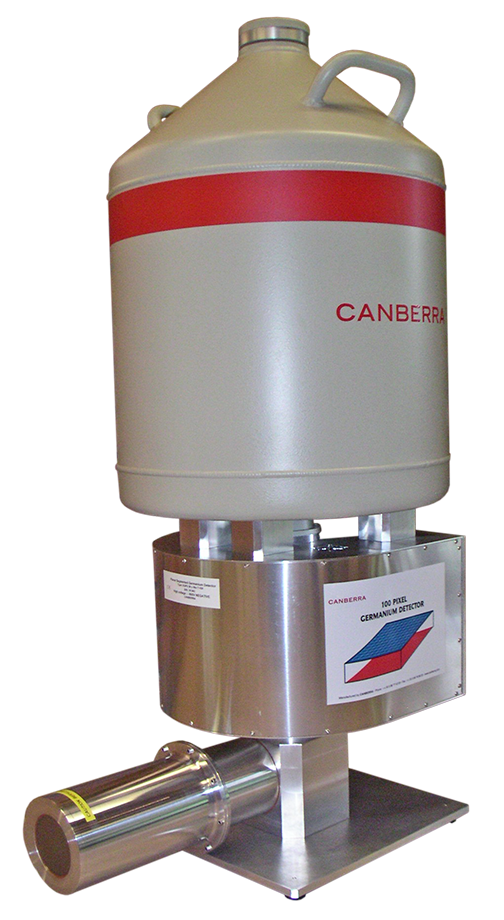
- For high performance X and g measurements in Physics, astrophysics, non-destructive control and medicine
- Unique proprietary segmentation techniques developed and enhanced for over 15 years
- Large range of shapes (pixels, strips) and segmentations (straight strips, circular, single or double sided)
- Excellent energy resolution
Scintillators
Scintillator Detector: Scintillation crystal is supplied mounted in a hermetically sealed metal container with an optical window to protect the crystal from hydration or from other environmental influences.

- Scintillation Detectors are NaI(Tl)/CsI(Tl)/CeBr3/BGO…etc
- Multiple Size Detectors with Voltage Dividers available
- Detector Entrance Window Options like Be, Al available
Pen Type Detectors: By using 10 mm diameter Pen-typephotomultiplier tubes, small scintillationcrystals (with or without an internal orexternal collimator) can provide information on activity, for example innode sentinel studies.

- NaI(Tl)scintillation crystal size 9.5 x 20 mm
- Coupled with HV, Amplifier & Single Channel Analyzer
- Overall Size is 112 mm x 31 mm x 62 mm
Photodiode Detectors: In particle physics experiments, square or rectangular CsI(Tl) crystals are combined into arrays or matrices to detect particles, usually in a E/ΔE setup with silicon detectors in front of the units.

- Maximum proton energy : 100 MeV protons
- Scintillation crystal : 50 x 50 x 25 mm CsI(Tl)
- Preamplifier : Charge sensitive, 30 V/pC Max gain can be chosen
SiPmReadout: SiPm readout can result in compact mechanically robust scintillation detectors especially when rugged scintillators like CsI(Tl) are used.The energy resolution and noise level achievable with SiPm readout depends on the crystal dimensions.
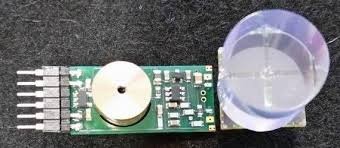
- Insensitive to magnetic fields
- High gains (106)
- Mechanically compact
- Elements 3×3 of 6×6 mm
Ruggedized detectors: Integral ruggedized detectors are characterized by special packing of the scintillation crystal with provisions to protect PMT and crystals against shocks and sudden temperature transitions.

- Scintillation Crystals:NaI(Tl), CsI(Na), CsI(Tl), BGO
- Temperature Range: -40 to +65 0C
- Vibrations: 50 RMS on 3 axis
- Shocks: 100 G
Compton Suppression Shields: A way to suppress these Compton scattered gamma rays is to surround the HpGe crystal with a scintillation material. For an optimum suppression, the suppression shield should be capable of detecting real low energy gamma rays down to 15 keV.
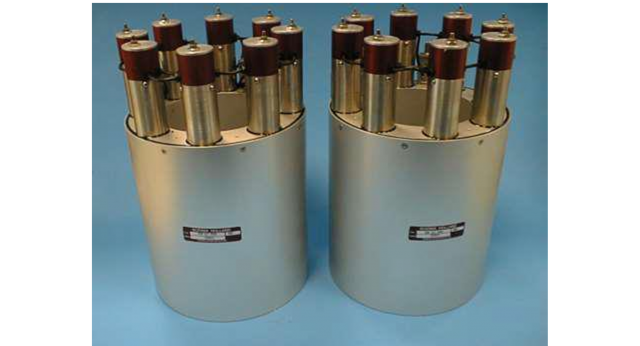
- Nuclear spectroscopy and Low-level detection Applications
- These are mainly found in physics: Euroball, Exogam, Tigress, Inga. Experiments.
CLLBC NEUTRON/GAMMA SCINTILLATION: Cesium Lanthanum Lithium BromoChloride) CLLBC , Cs2LiLaBr4.8Cl1.2:Ce
scintillators have properties to the well-known LaBr3:Ce crystals. Energy resolutions
around 3 % FWHM (662 keV) are standard.
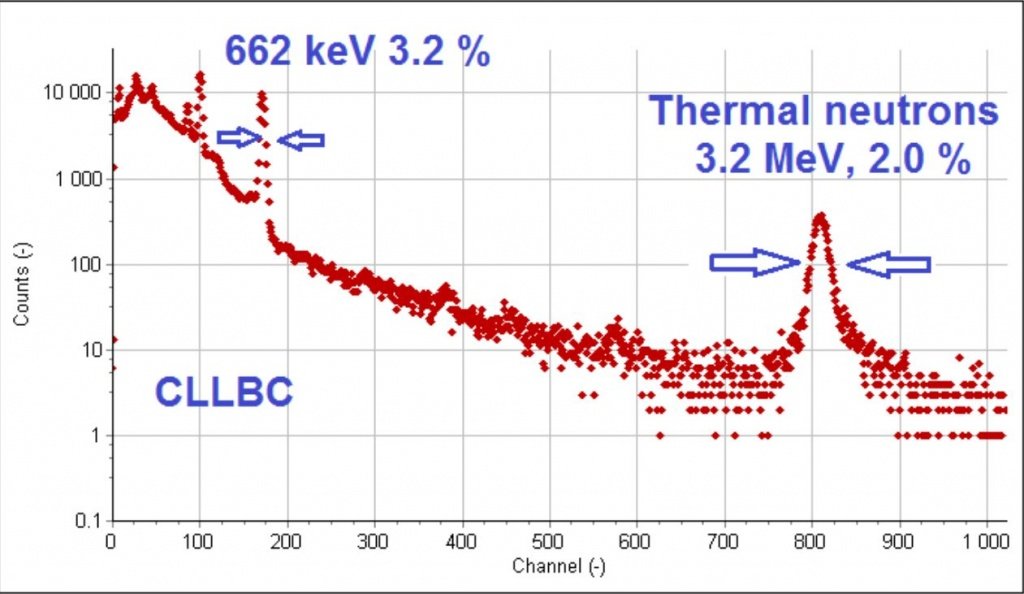
- Offers Excellent Neutron / Gamma discrimination using PSD
- Energy resolutions around 3 % FWHM (662 keV)
- Hygrosopic, 6-Lithium enrichment
- Photoelectron yield compared to NaI(Tl) : 70 % (1.5 µs shaping time), 84 % (12 µs shaping time)
- Maximum Emission : 420 nm
THE NEW GENERATION SCINTILLATOR/ SIPM DETECTORS: The currently available silicon photomutipliers allow the design of compact low power sensors applicable in numerous applications. With a carefull choice of the number of
SiPms per scintillation crystal, the energy resolution and noise can tuned / managed
within the desired temperature range
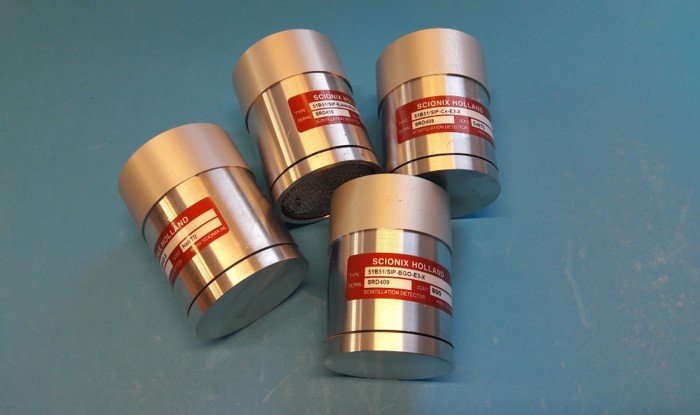
- Compact
- Low power (5 V , 5 mA)
- Built-in temperature compensated bias generator / preamplifier
- PMT readout comparable energy resolution
- Wide choice of scintillator
Cryostats, coolers and accessories
Electrically Refrigerated Cryostat, Cryo-Pulse 5 Plus: The Cryo-Pulse 5 Plus unit is an electrically powered cryostat for use with HPGe radiation detectors. It utilizes a pulse tube cooler, a highly reliable technology originally used in military and space applications and which has proven its value for germanium detectors in the original Cryo-Pulse 5 cryostat.
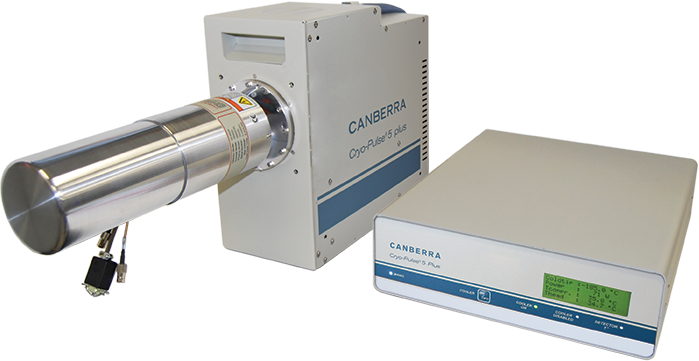
- Completely LN2 free
- 5-year full warranty on coldhead
- Non-CFC/non-flammable refrigerant
- MTTF >3,000,000 hours
Cryo-Cycle II Hybrid cryostat: The Cryo-Cycle II cryostat is described as a “hybrid” cryostat because it combines the advantages of electric cooling with the reliability of liquid nitrogen.
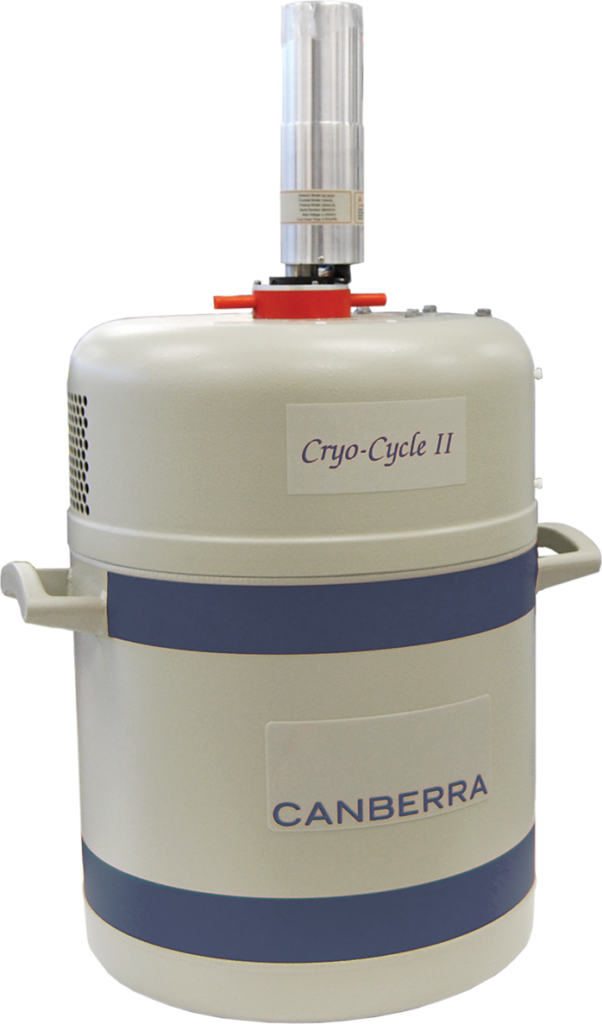
- LN2 redundancy
- Non-CFC/non-flammable refrigerant
- Low power demand
- Same footprint as standard LN2 Dewar
Slimline Cryostat: Slimline cryostats are designed so that the detector and electronics both fit in a cylindrical housing without any protruding flanges, valves, and preamplifier enclosures.
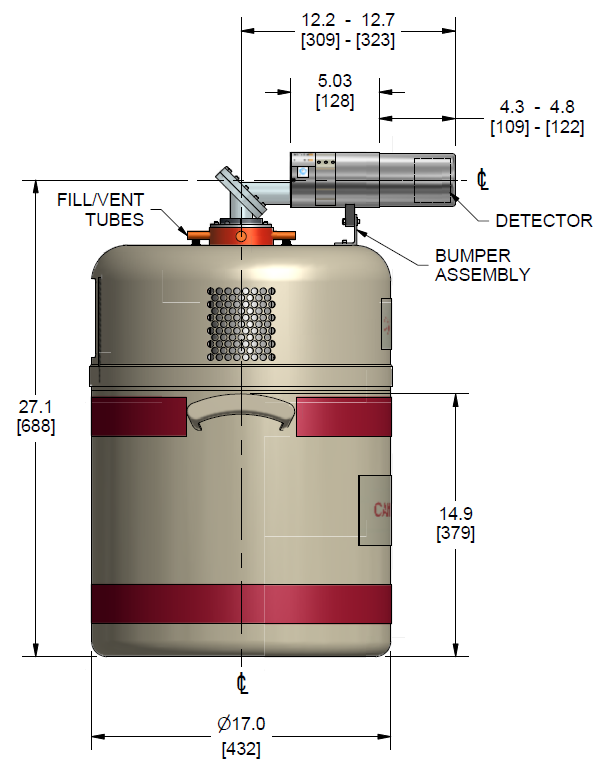
- cylindrical housing without flanges
- Compact integration for lead shield application
- Remote Detector chamber option
- significantly reduces the radiation background
U-Style Cryostat: U-Style cryostats have a vertically-oriented detector chamber located at the end of a horizontal arm extending from the side of the Dewar or cooler.

- Lower centre of gravity for detector and shield
- Reduces background significantly
- Good mobile applications
- horizontal arm is 12 inches
Ultra Low Background Cryostat: Mirion has years of experience in building custom low-background detectors for low level gamma spectroscopy. The most important features of these custom detectors have been incorporated into standardized cryostat designs which can be produced quickly and economically and which produce predictable results.

- Aluminum−99.999% pure with guaranteed thorium and uranium less than 1 ppb.
- Copper-99.99% pure (better than standard OFHC grade).
- Stainless Steel − selected low 60Co content.
- Composite Carbon−Virtually zero background substitute for Be in low energy and wide range detectors
7170 LN2 Level Gauge/Controller: The Model 7170 LN2 Level Gauge provides a digital display of LN2 level in a Dewar or container along with adjustable low and high level setpoints which initiate audible and visible alarm signals as well as a relay output for remote monitoring. The display shows liquid level from 0-100% of the active sensor length.

- Color touch display
- RJ-45 and RS-232 outputs
- Level based valve control
- Configurable alarm setpoints
HPGe Shields: Lead shields prevent high background counts with gamma detectors due to external sources, thus reducing counting times and improving the lower limit of detection. An active shield option using cosmic veto technology is also available to minimize background further for ultra-low background detector applications.

- Available in Various sizes
- Available in various configuration
- Available in Compton suppression mode
- Available in various thickness
Alpha Spectroscopy
Integrated Alpha Spectrometer, Alpha Analyst: The Alpha Analyst system along with Apex-Alpha™ software is the complete solution for both routine and non-routine alpha spectroscopy applications.
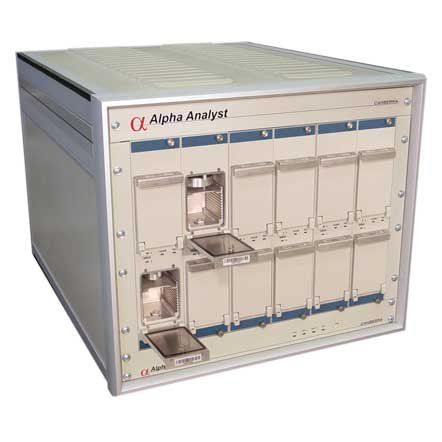
- Completely integrated alpha spectroscopy instrument
- 100% computer controlled electronics and vacuum
- Automatic recoil suppression control
- Modular for ease of expansion
Alpha Spectroscopy Accessories: Alpha spectroscopy is especially crucial for waste management and site decommissioning and decontamination applications.
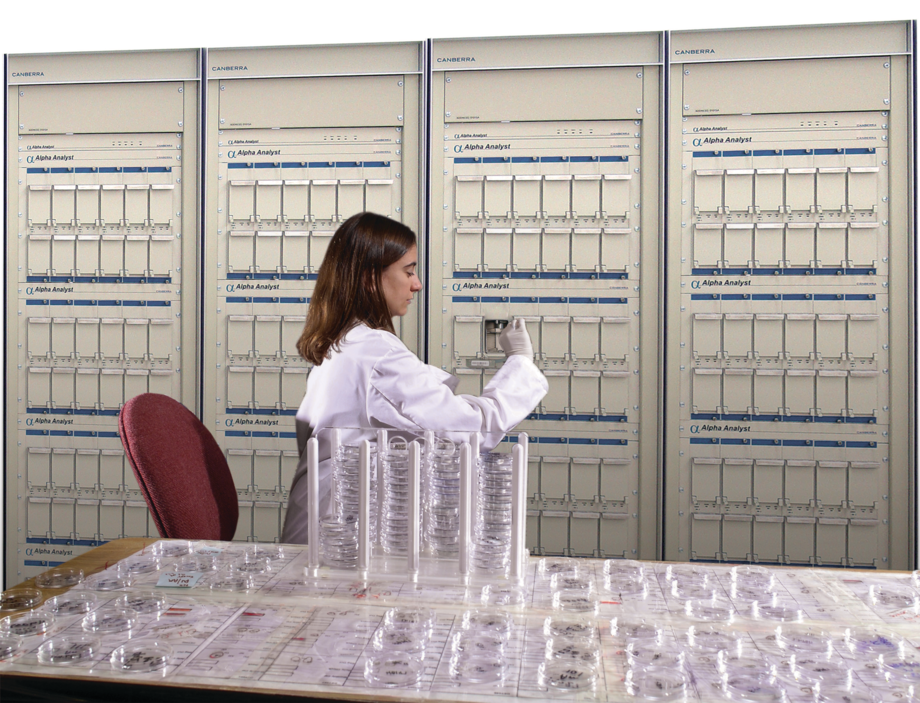
- Vacuum pump
- inlet filter
- Exhaust filter kit
- Installation kit
Passivated Implanted Planar Silicon Detectors: The Passivated Implanted Planar Silicon (PIPS) Detector is a product of modern semiconductor technology. In most applications, this detector replaces silicon surface barrier (SSB) detectors and diffused junction (DJ) detectors, both of which are still made the same way they were made in 1960. The PIPS detector has a number of advantages over SDB and DJ types:

Alpha/Beta Counting Systems
Automatic Low Background Alpha/Beta Counting System, Series 6LB: The Series 6LB counter uses the novel “system on slide” concept where the shield is fixed in place while the entire sample changer and detector smoothly slides out and away from it.
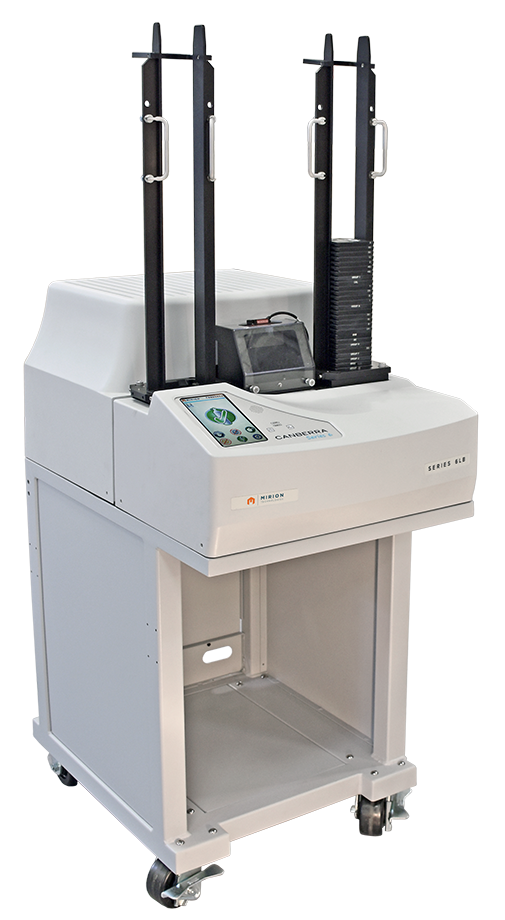
- 2.25” Gas Flow Proportional Counter with 50 or 100 sample capacity
- Complete frontal access with no need to lift lead bricks to access the detector – changer slides away from lead castle
- Integrated touch screen interface
- Coated and bolted lead shield
Automatic Low Background Alpha/Beta Counting System, Series 5XLB: Superior Counting Performance, Unparalleled System Features The Series 5 XLB low background alpha /beta counter offers a completely integrated, computer controlled system for maximum flexibility.
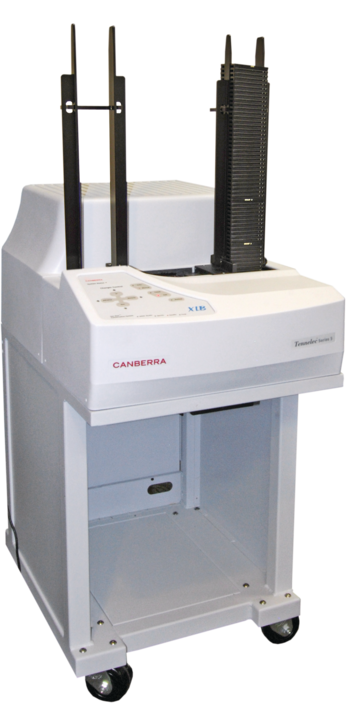
- Automatic single detector, ultra-low background counting system
- Enhanced low background capability
- Gas Stat digital gas conservation and monitoring system
- Fifty planchet sample changer with 100 sample capacity optional
Large Area Automatic Low Background Alpha/Beta Counting System, LB5500: Large Area Counting System The Series 5 LB5500 low background alpha /beta counter offers a completely integrated, computer controlled system for maximum flexibility in analyzing larger size samples. The LB5500 system is designed for counting large samples, up to 12.7 cm (5 in.) in diameter.

- Automatic single 5 inch detector,ultra-low background counting system
- Enhanced low background capability
- Gas Stat digital gas conservation and monitoring system
- Fifty planchet sample changer
Multi-Detector Low Background Alpha/Beta Counting System, LB4200: The LB4200 counter is the advanced alpha/beta counting system designed to simplify lab operations. The LB4200 system is perfect for applications requiring high sample throughput with long counting times, or where a number of samples must be counted at the same time.
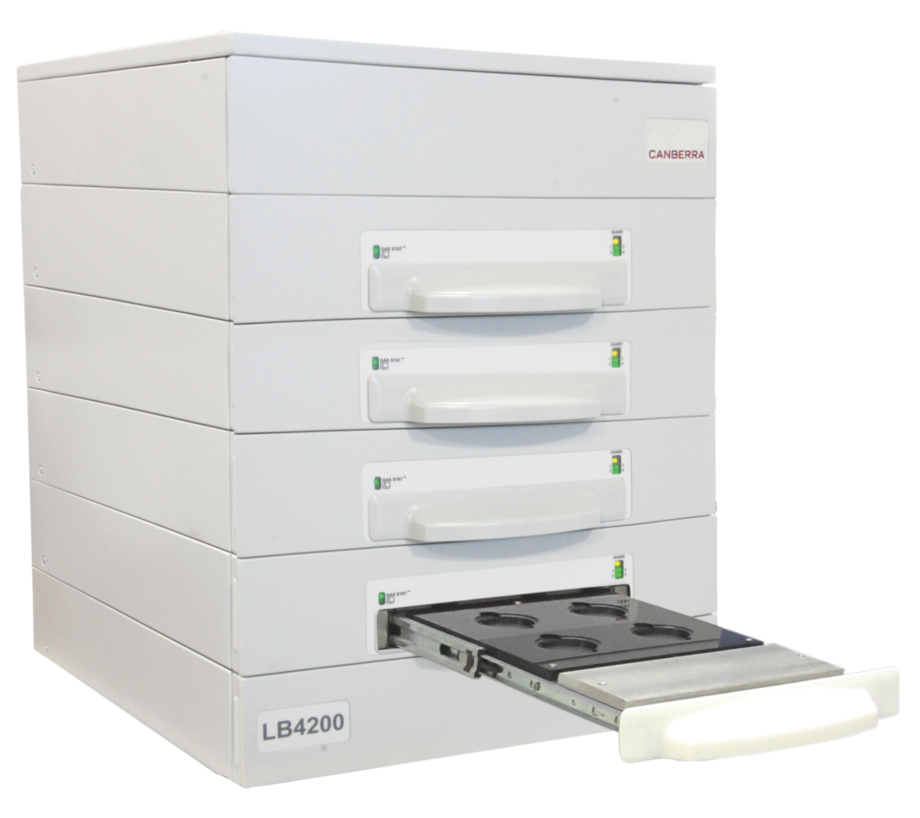
- An advanced alpha/beta analysis instrument with up to 50% lower counting gas usage
- 30% lower background than previous generations of counters
- Delivers fewer gas changes (and associated re-calibrations) and reduced count times to meet required MDAs
- Flexible configuration from one to four counting drawers
Alpha/Beta Counting System, iSOLO: The iSolo® system is a portable, firmware based, single-sample, manual, gas-less alpha/beta counter. The iSolo counter is designed for the analysis of air filters and most other types of alpha/beta samples. When analyzing air filters, the iSolo counter discriminates both radon and thoron and their progeny from transuranic and fission product materials on the air filter samples.
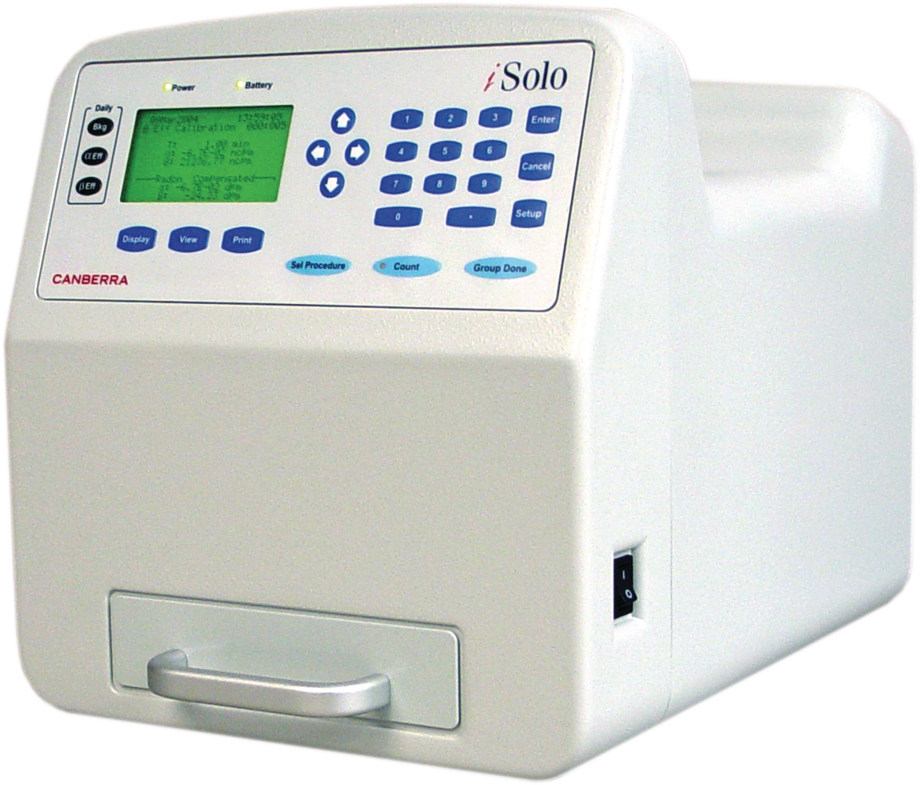
- Portable, manual, singlesample alpha/beta counter
- Automatically identifies and compensates for radon, thoron and progeny interference in air filters
- Can be used for other types of samples without radon /thoron compensation
- PIPS® silicon gas-less detector
Gas-less Automatic Alpha/Beta Counting System, iMatic: The iMatic system is a firmware based, automatic, low background, gas-less alpha/beta counter designed specifically for the analysis of air filters and smear or swipe samples.The iMatic system discriminates both radon isotopes and their progeny from transuranic and fission product materials on the samples.
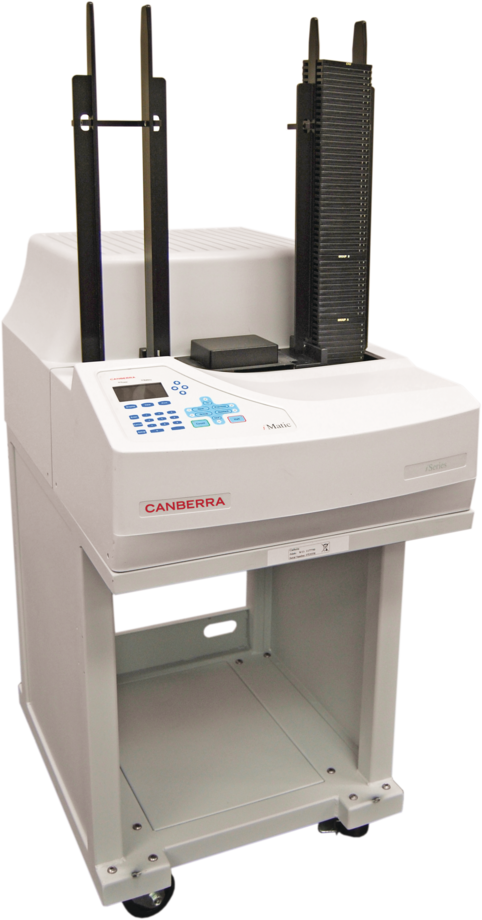
- Automatic sample changer with 50 or 100 sample capacity
- Automatically identifies and compensates for radon, thoron and progeny interference
- PIPS® silicon gas-less detector
- Developed primarily for air filter analysis
Field Application
Portable HPGe Spectrometer, Aegis: The Aegis Portable HPGe Spectrometer is the newest transportable, battery-powered HPGe gamma spectrometer in Mirion’s portfolio. Like its Falcon 5000® predecessor, it offers many state-of-the-art features, such as a thermal-cycle free cryostat, an integrated all-in-one design and laboratory-grade energy resolution.
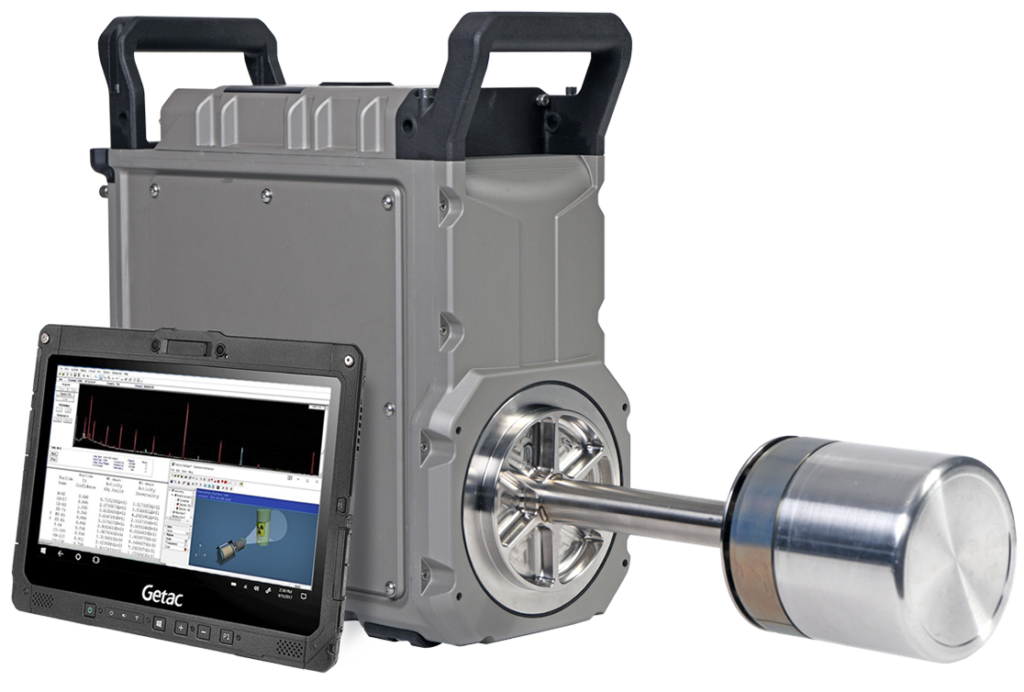
- Thermal-cycle free cryostat
- Laboratory-grade energy resolution
- Choice of large 40% and 50% HPGe crystals
- RDC option enabling backshielding
Radionuclide Identification Device, Spir Ace with Genie export: The SPIR-Ace is a versatile Radionuclide Identification Device (RID) addressing all applications requiring efficient detection and identification of radiological threats and assessment of nuclear materials for security applications, power plants, safeguards inspections, and forensic laboratories.
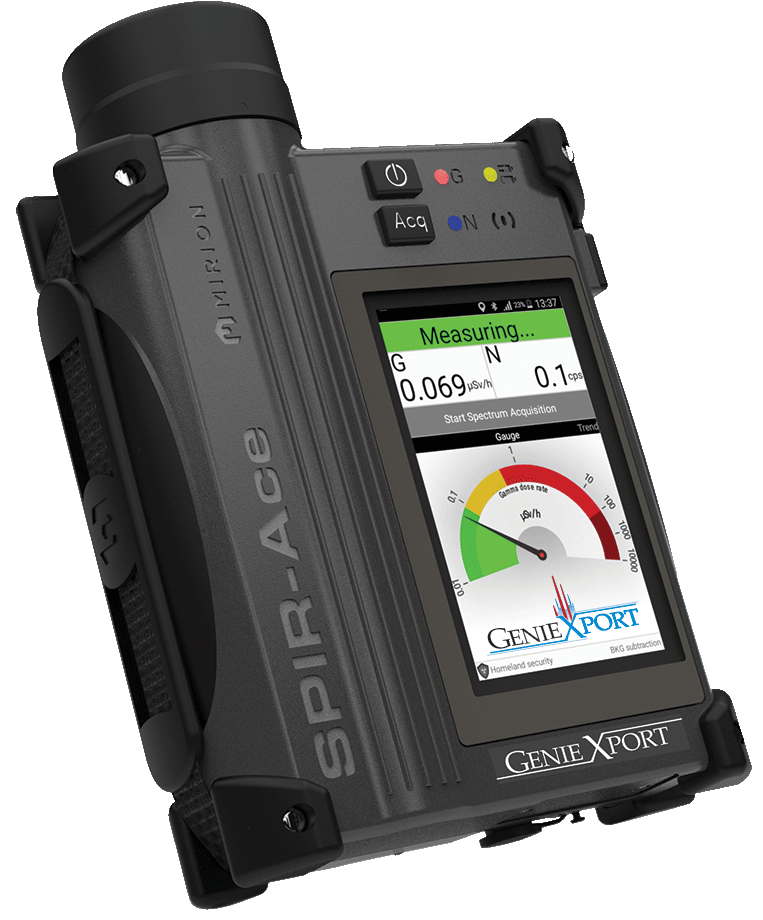
- Versatile use for search, detect and identification operations
- Solves heavily shielded and unbalanced Special Nuclear Material masking scenarios
- Simple operation with versatile alarm modes
- Energy-stabilized (without a source), for use in variable temperatures
Transportable Radiation Analysis Counting System, Tracs: A complete and scalable ultra-portable sample counting solution for use outside of the laboratory.Ranging from a single, stand-alone counter to a fleet of counters with remote expert data review capability, the TRACS/Genie-FieldPro solution can be easily sized to fit your needs.
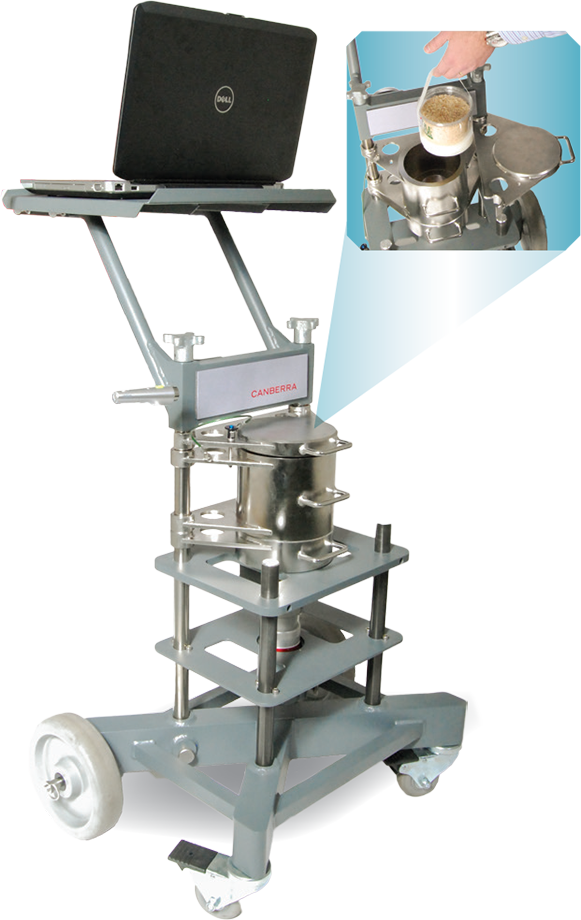
- 9 main shield components no heavier than 9 kg (20 lb) eac
- Set of travel cases available for shipping
- easy loading/unloading the cart to/from a car
- Assembly in less than 10 minutes without any tools
Radiological Food Screening System, Foodscreen: The Mirion FoodScreen Radiological Food Screening System is a complete, transportable food analyzer for quickly determining whether raw or processed food has become contaminated from a radiological event. A sample is placed into the shield, a count is initiated and a final report is generated.
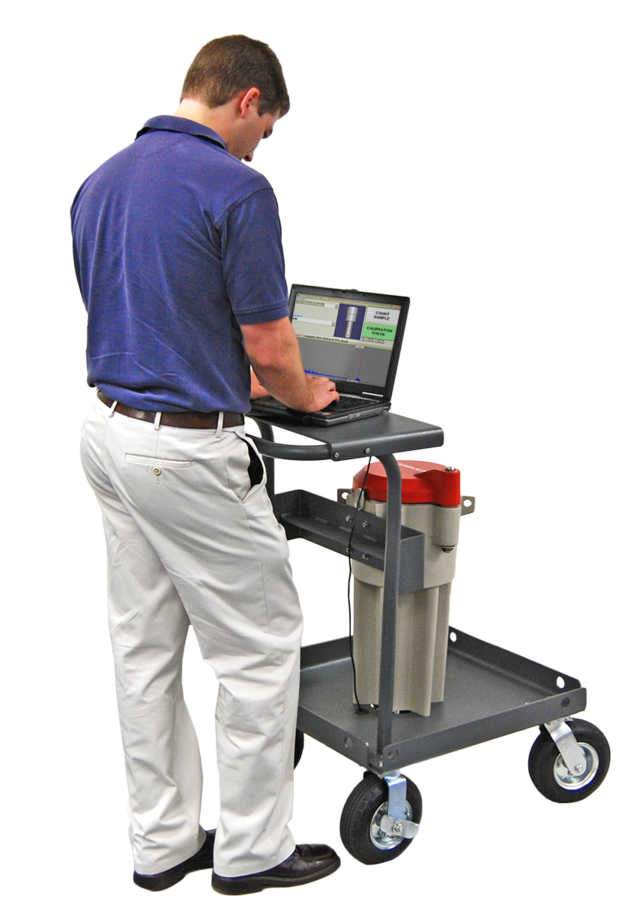
- Rapid screening of processed or raw food products for key 131I, 134Cs and 137Cs nuclides
- Clear, immediate indication if any nuclide-specific maximum permissible concentrations are exceeded.
DSP Portable Spectroscopy Workstation, Inspector 2000: The InSpector 2000 instrument is a high performance, portable spectroscopy workstation based on Digital Signal Processing (DSP) technology. Applications for the InSpector 2000 unit include all HPGe, NaI and Cd(Zn)Te detector applications common in environmental characterization; nuclear safeguards; decommissioning and decontamination; and in-facility monitoring.
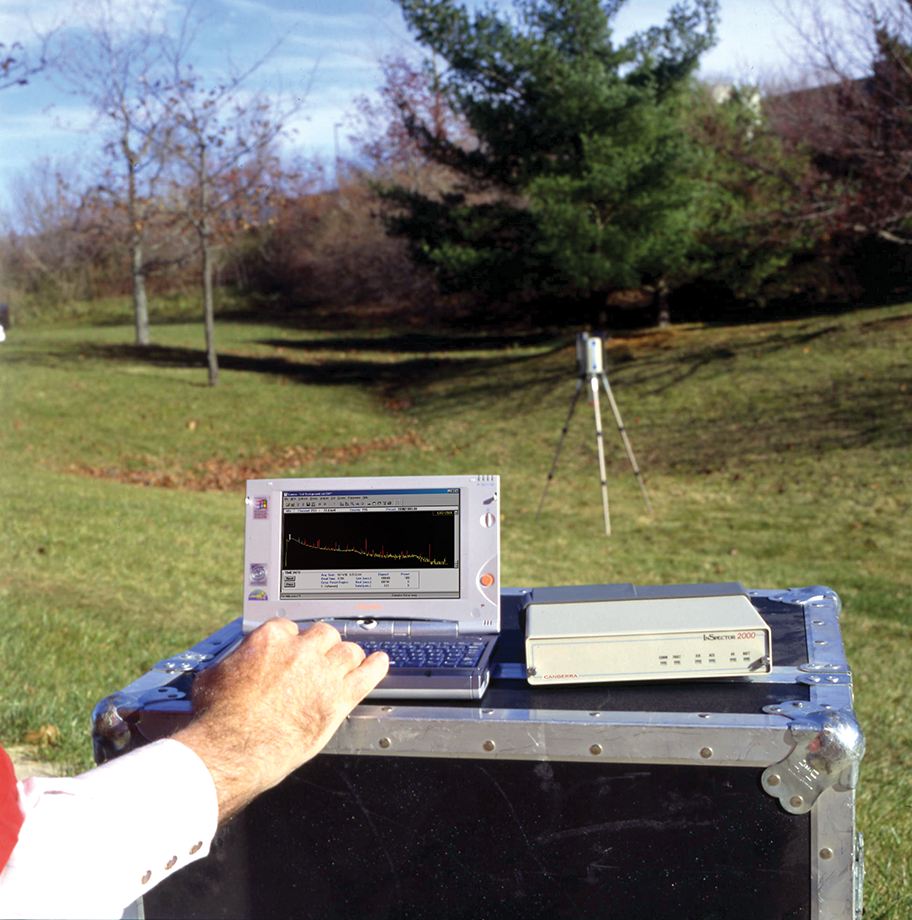
- Unsurpassed temperature stability
- Accommodates a wide dynamic range of count rates, minimal loss of spectrum resolution
- Low system dead time
Continuous Spectroscopic Monitor,CSM- GR1: The CSM-GR1 Continuous Spectroscopic Monitor is a very small, yet powerful, in situ measurement system based on standard and well-established Canberra™ gamma spectroscopy components.
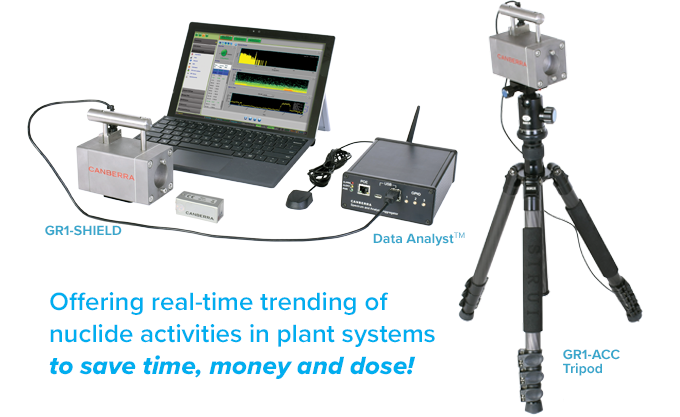
- All-in-one detector, electronics, and MCA
- Pre-set Gain, 1 cm3 CZT solid state detector
- Miniaturized package: 25 x 25 x 63 mm, 60 g
- Optional Generic ISOCS™ characterization available
ISOCS™ Shield Systems, ISOXSHLD: This ISOCS (In Situ Object Counting System) Shield (Figure 1) has been designed as the optimum in convenience and functionality for in situ gamma spectroscopy with a germanium detector.
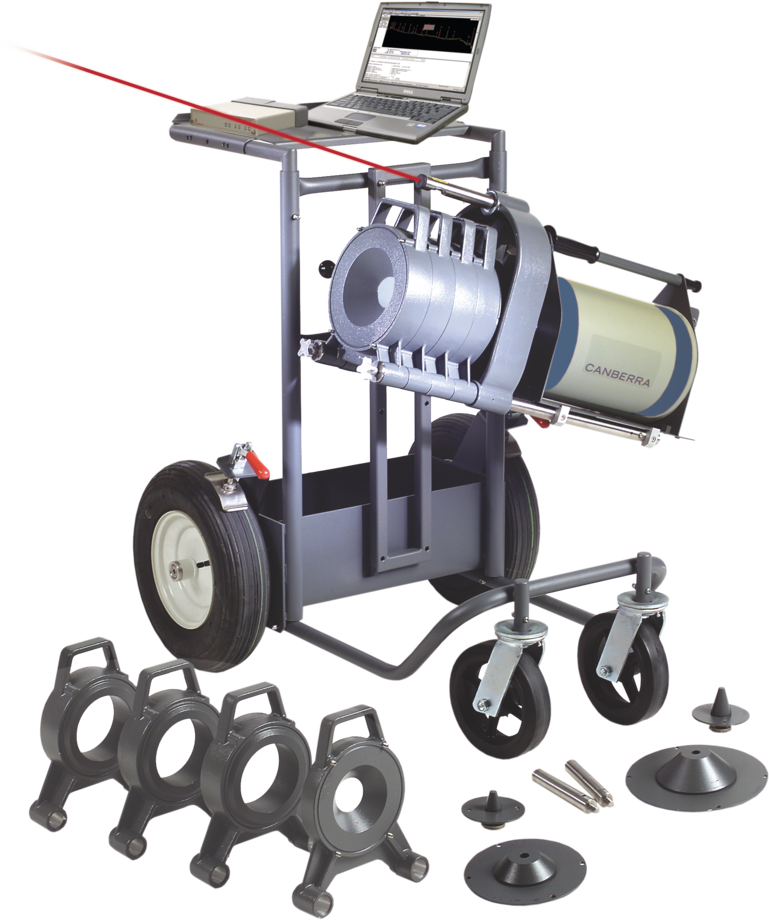
- Portable Germanium detector shield system for in situ assays
- Includes 25 mm and 50 mm thick lead shields
- Reduces interfering 1000 keV radiation by a factor of 7.5 (25 mm) and 60 (50 mm)
- Modular design for easy handling

